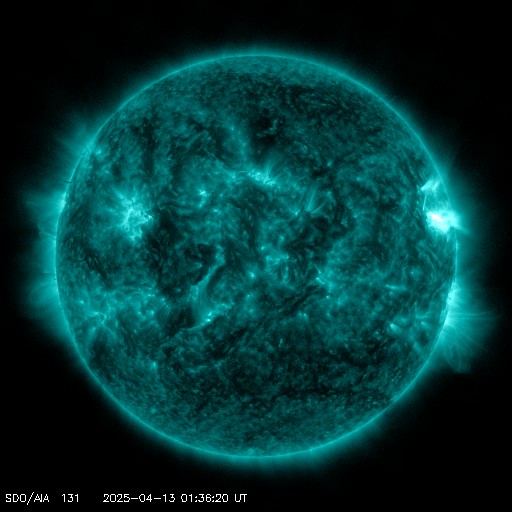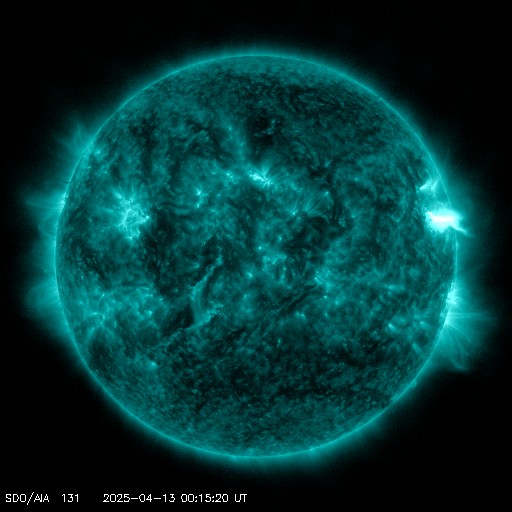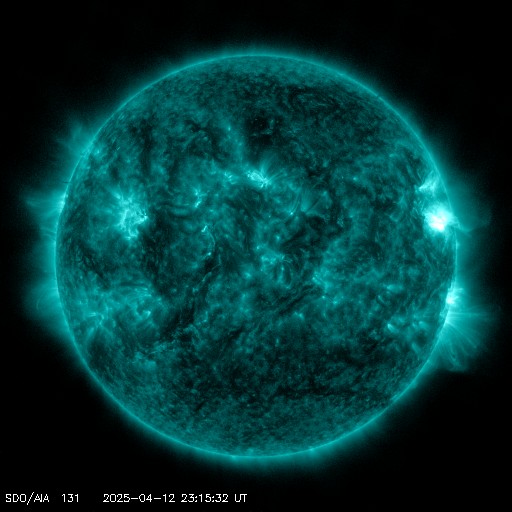Het archief bekijken van zondag 25 februari 2024
Dagelijks bulletin over zonne- en geomagnetische activiteit van het SIDC
Datum verslag: 2024 Feb 25 1259 UTC
SIDC Prognose
Zonnevlammen
M-class flares expected (probability >=50%)
Geomagnetisme
Active conditions expected (A>=20 or K=4)
Proton Flux monitor
Quiet
| 10cm flux | Ap | |
|---|---|---|
| 25 Feb 2024 | 183 | 013 |
| 26 Feb 2024 | 185 | 011 |
| 27 Feb 2024 | 187 | 010 |
Zonnevlekkengebieden en zonnevlammen
Solar flaring activity over the past 24 hours was at low levels. The largest flare was a C7.8-flare, with peak time 17:56 UTC on February 24 associated with NOAA AR 3590 (beta-gamma-delta). The second largest flare was C5.8-flare, with peak time 17:25 associated with NOAA AR 3592 (beta). There are currently 5 numbered active regions on the visible disk. NOAA AR 3590 (beta-gamma-delta) is the largest, most magnetically complex region and has produced most of the flaring activity in the last 24 hours. NOAA AR 3586 (alfa) has started to rotate over the west limb. A new yet unnumbered active region has started to emerge on the north-east quadrant of the visible Solar disk. All other regions were inactive and stable. The solar flaring activity is likely to be at moderate levels over the coming days with C-class flares expected and M-class flares possible and a chance for an X-class flare.
Coronale massa uitstoten
A Coronal Mass Ejections (CME)s, was detected in LASCO C2 data at 17:00 UTC on February 24, it was mainly directed towards the east and is associated with a C5.8-flare, with peak time 17:25 associated with NOAA AR 3592. No impact from this CME is expected at Earth.
Coronale gaten
Two negative polarity coronal holes have passed the central meridian. One in the northern half of the Sun at high latitude and the other in the Southern half at low latitude. The Southern coronal hole is currently in a geo-effective position.
Zonnewind
In the last 24 hours, the Earth came under the influence a high-speed stream associated with a negative polarity coronal hole, which crossed the central meridian on February 23 and became further perturbed because of the arrival of a ICME from February 21. A shock in the solar wind shows the arrival of the high-speed stream. The solar wind speed jumped from around 309 km/s to around 380 km/s and the interplanetary magnetic field jumped from 5 nT to 10 nT at 16:20 UTC on February 24. At around 00:40 UTC on February 25 the Earth came under the influence of a ICME after which the solar wind speed reached maximum values of around 450 km/s and the interplanetary magnetic field reached a value of 11 nT, with a minimum Bz value of -10 nT. Over the entire period the phi-angle was mainly in the negative sector (directed towards the Sun) with periods on the positive sector. In the next 24 hours, the solar wind conditions are expected to be disturbed under the influence of the high-speed-stream and ICME.
Geomagnetisme
Geomagnetic conditions globally and locally reached unsettled conditions (Kp 3 and K Bel 3). Unsettled to active conditions are expected in the next 24 hours.
Proton flux niveaus
Over the past 24 hours the greater than 10 MeV GOES proton flux was at nominal levels and is expected to remain so over the next days. Some enhancements are possible in the case of an eruptive activity from NOAA AR 3590.
Elektronenfluxen in geostationaire baan
The greater than 2 MeV GOES 16 electron flux was below the 1000 pfu threshold and is expected to remain so in the upcoming days. The 24h electron fluence was at nominal level and is expected to remain so in the next days.
Het geschatte internationale zonnevlekkengetal (ISN) van vandaag: 118, gebaseerd op 07 stations.Zon indexen voor 24 Feb 2024
| Wolfgetal Catania | /// |
| 10cm zonneflux | 179 |
| AK Chambon La Forêt | 014 |
| AK Wingst | 008 |
| Geschatte Ap | 006 |
| Geschat internationaal zonnevlekkengetal | 104 - Gebaseerd op 20 stations |
Overzicht opvallende gebeurtenissen
| Dag | Start | Max | Einde | Locatie | Sterkte | OP | 10cm | Catania/NOAA | Soorten radio-uitbarstingen |
|---|---|---|---|---|---|---|---|---|---|
| 24 | 1154 | 1159 | 1204 | ---- | M1.0 | 85/3590 |
Aangeboden door het Solar Influences Data Analysis Center© - SIDC - Verwerkt door SpaceWeatherLive
Alle tijden in UTC
<< Keer terug naar de dagelijkse overview pagina
Op basis van de huidige parameters is er in de nabije toekomst een beperkte kans op poollicht op de volgende locaties van de hoge breedtegraad
Gillam, MB, Iqaluit, NUNuuk
Reykjavik
Laatste nieuws
Laatste forumberichten
Steun Poollicht.be!
Om ook bereikbaar te blijven bij grote poollichtkansen hebben we een zware server nodig die alle bezoekers aankan. Doneer en steun dit project zodat we online blijven en je geen enkele poollichtkans mist!

Laatste alerts
01:51 UTC - Zonnevlam
Matige M1.09 zonnevlam
01:30 UTC - Radio blackout
Kleine R1 radio blackout gedetecteerd (≥M1 - momenteel: M1.01)
00:27 UTC - Zonnevlam
Matige M1.32 zonnevlam
zaterdag 12 april 2025
23:54 UTC - Radio blackout
Kleine R1 radio blackout gedetecteerd (≥M1 - momenteel: M1.08)
23:27 UTC - Zonnevlam
Matige M1.27 zonnevlam
Ruimteweer feitjes
| Laatste X-klasse uitbarsting | 28/03/2025 | X1.1 |
| Laatste M-klasse uitbarsting | 12/04/2025 | M1.3 |
| Laatste geomagnetische storm | 06/04/2025 | Kp5 (G1) |
| Zonnevlekkenloze dagen | |
|---|---|
| Laatste zonnevlekkenloze dag | 08/06/2022 |
| Maandelijks gemiddeld zonnevlekkengetal | |
|---|---|
| maart 2025 | 134.2 -20.4 |
| april 2025 | 139.5 +5.3 |
| Afgelopen 30 dagen | 135.8 -6.1 |





